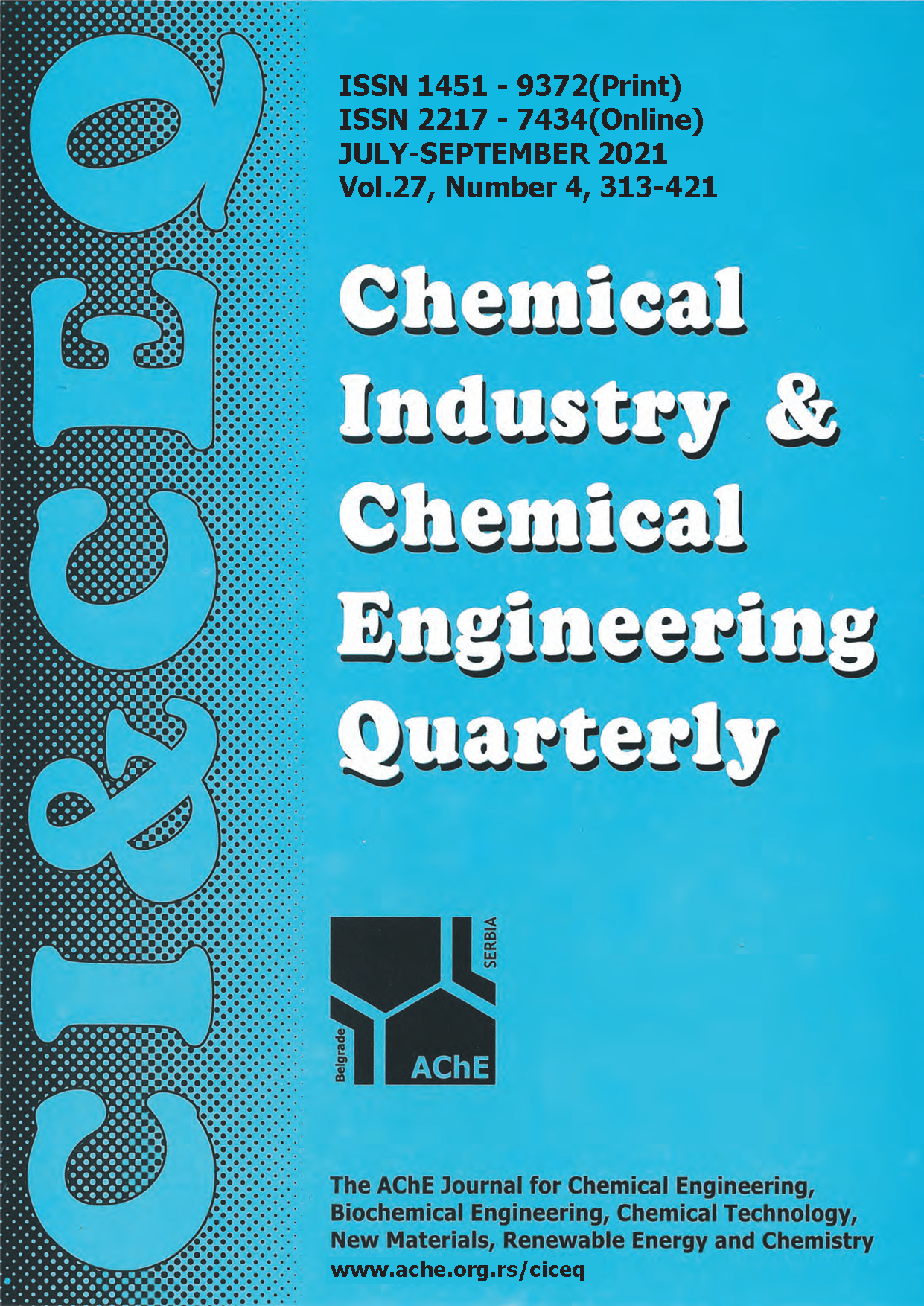NEWLY SUGGESTED SHAPES OF IMPELLERS FOR STIRRING HIGHLY VISCOUS FLUIDS IN VESSELS
Scientific paper
DOI:
https://doi.org/10.2298/CICEQ201013005AKeywords:
close clearance impellers, stirred tanks, highly viscous fluids, modified anchor impellers, CFDAbstract
The power consumption and flow patterns generated in a cylindrical stirred tank are determined. The anchor impeller is used to ensure the agitation of highly viscous fluids. New modifications in the impeller design are introduced to improve the stirring rates. Firstly, the lower corner of the conventional anchor is replaced by an inclined segment to obtain Case No. 1. The number of segments was then increased to reach a closed circular shape (Case No. 2). Further increase in the number of segments was introduced to reach a perfect circular blade (Case No. 3) in the vertical direction. Finally, another circular horizontal blade was added to obtain Case No. 4. From the obtained results, Case No. 4 provided a great improvement in the circulation of fluid particles inside the vessel and generated the widest well-stirred region.
References
S. Deshpande, K. Kar, J. Walker, J. Pressler, W. Su, Chem. Eng. Sci. 168 (2017) 495-506
G. Janiga, Chem. Eng. Sci. 201 (2019) 132-144
H. Ameur, Chem. Eng. Proc. Process Intensif. 154 (2020) 108009
M. Foukrach, H. Ameur, Chem. Ind. Chem. Eng. Q. 26 (2020) 259-266
H. Ameur, Energy 93 (2015) 1980-1988
P. Prajapati, F. Ein‐Mozaffari, Chem. Eng. Technol. 32 (2009) 1211-1218
H. Ameur, ChemistrySelect 2 (2017) 11492-11496
B. Triveni, B. Vishwanadham, T. Madhavi, S. Venkateshwar, Chem. Eng. Res. Des. 88 (2010) 809-818
S. Woziwodzki, L. Broniarz‐Press, M. Ochowiak, Chem. Eng. Technol. 33 (2010) 1099-1106
R.P. Chhabra, J.F. Richardson, Non-Newtonian flow in the process industries: fundamentals and engineering applications, Butterworth-Heinemann, Oxford, 1999
M. Ohta, M. Kuriyama, K. Arai, S. Saito, J. Chem. Eng. Japan 18 (1985) 81-84
S. Karray, Z. Driss, H. Kchaou, M. Abid, Eng. Appl. Comp. Fluid Mech. 5 (2011) 315-328
T. Espinosa-Solares, E.B.-D.L. Fuente, F. Thibault, P. Tanguy, Chem. Eng. Commun. 157 (1997) 65-71
B. Triveni, B. Vishwanadham, S. Venkateshwar, Heat Mass Transfer 44 (2008) 1281-1288
H. Ameur, J. Hydrodyn. 28 (2016) 669-675
H. Ameur, A. Ghenaim, ChemistrySelect 3 (2018) 7472-7477
Y. Kamla, H. Ameur, A. Karas, M.I. Arab, Chem. Pap. 74 (2020) 779-785
R. Alcamo, G. Micale, F. Grisafi, A. Brucato, M. Ciofalo, Chem. Eng. Sci. 60 (2005) 2303-2316
A. Khapre, B. Munshi, J. Taiwan Inst. Chem. Eng. 56 (2015) 16-27
A. Hadjeb, M. Bouzit, Y. Kamla, H. Ameur, Polish J. Chem. Technol. 19 (2017) 83-91
H. Ameur, Chin. J. Chem. Eng. 24 (2016) 572-580
H. Ameur, Int. J. Chem. React. Eng. 14 (2016) 1025-1033
H. Ameur, J. Food Eng. 233 (2018) 117-125
D. Anne-Archard, H. C. Boisson, M. Marouche, in Proceedings of 18ème Congrès Français de Mécanique, Grenoble, France, 2007, pp. 27-31.
Downloads
Published
Issue
Section
License

This work is licensed under a Creative Commons Attribution-NonCommercial-NoDerivatives 4.0 International License.
Authors who publish with this journal agree to the following terms:
Authors retain copyright and grant the journal right of first publication with the work simultaneously licensed under a Creative Commons Attribution License that allows others to share the work with an acknowledgement of the work's authorship and initial publication in this journal.
Authors grant to the Publisher the following rights to the manuscript, including any supplemental material, and any parts, extracts or elements thereof:
- the right to reproduce and distribute the Manuscript in printed form, including print-on-demand;
- the right to produce prepublications, reprints, and special editions of the Manuscript;
- the right to translate the Manuscript into other languages;
- the right to reproduce the Manuscript using photomechanical or similar means including, but not limited to photocopy, and the right to distribute these reproductions;
- the right to reproduce and distribute the Manuscript electronically or optically on any and all data carriers or storage media – especially in machine readable/digitalized form on data carriers such as hard drive, CD-Rom, DVD, Blu-ray Disc (BD), Mini-Disk, data tape – and the right to reproduce and distribute the Article via these data carriers;
- the right to store the Manuscript in databases, including online databases, and the right of transmission of the Manuscript in all technical systems and modes;
- the right to make the Manuscript available to the public or to closed user groups on individual demand, for use on monitors or other readers (including e-books), and in printable form for the user, either via the internet, other online services, or via internal or external networks.






